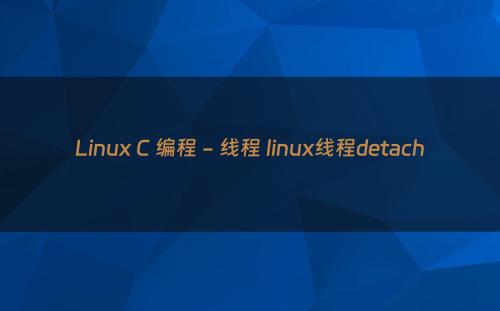网站首页 > 基础教程 正文
- 概念
线程库函数是由POSIX标准定义的,称为POSIX thread或者pthread。在Liunx上线程函数位于libpthread共享库中,因此在编译时要加上-lpthread选项。
- 线程控制
- 创建线程
#include <pthread.h>
int pthread_create(pthread_t *restrict thread,
const pthread_attr_t *restrict attr,
void *(*start_routine)(void*), void *restrict arg);返回值:成功返回0,失败返回错误号。以前学过的系统函数都是成功返回0,失败返回-1,而错误号保存在全局变量errno中,而pthread库的函数都是通过返回值返回错误号,虽然每个线程也都有一个errno, 但这是为了兼容其它函数接口而提供的,pthread库本身并没有使用它,通过返回值返回错误码更加清晰。

pthread_create成功返回后,新创建的线程id被填写到thread参数所指向的内存单元。进程id的类型是pid_t, 每个进程的id在整个系统中是唯一的,调用getpid可以获得当前进程的id, 是一个正整数值。线程id的类型是thread_t, 它只在当前进程中保证是唯一的,在不同的系统中thread_t 这个类型有不同的实现,它可能是一个整数值,也可能是一个结构体,也可能是一个地址,所以不能简单地当成整数用printf打印,调用pthread_self可以获取当前线程的id。
attr参数表示线程属性,传NULL给attr参数,表示线程属性取缺省值。
#include<stdio.h>
#include <unistd.h>
#include <pthread.h>
#include <sys/types.h>
pthread_t c_pid;
void *printargs(void *msg)
{
char *str = (char *)msg;
printf("pthread_self() = %u\n", (unsigned int)pthread_self());
printf("str = %s\n", str);
return NULL;
}
int main()
{
int ret = 0;
pid_t pid;
/* get process id */
pid = getpid();
ret = pthread_create(&c_pid, NULL, printargs, "hello world");
if (ret)
{
printf("create thread failed!!!\n");
}
printf("pid = %d\n", pid);
sleep(1);
return 0;
}编译运行结果:
$ gcc thread_test.c -lpthread -o thread_test
$ ./thread_test
pid = 29534
str = hello world#include<stdio.h>
#include <unistd.h>
#include <pthread.h>
#include <sys/types.h>
pthread_t c_pid;
void *printargs(void *msg)
{
char *str = (char *)msg;
printf("str = %s\n", str);
printf("pthread_self() = %u\n", (unsigned int)pthread_self());
return NULL;
}
int main()
{
int ret = 0;
pid_t pid;
/* get process id */
pid = getpid();
ret = pthread_create(&c_pid, NULL, printargs, "hello world");
if (ret)
{
printf("create thread failed!!!\n");
}
printf("pid = %u\n", (unsigned int)pid);
printf("c_pid = %u\n", (unsigned int)c_pid);
sleep(1);
return 0;
}编译运行结果:
$ gcc thread_test.c -lpthread -o thread_test
$ ./thread_test
pid = 31001
c_pid = 2695579392
str = hello world
pthread_self() = 2695579392存在全局变量中ntid中保存的新创建的线程id, 和在新创建的线程中使用pthread_self获取到的线程id 是完全相同的。
如果任意一个线程调用了exit或_exit,则整个进程的所有线程都都终止了,由于从main函数return 也相当于调用exit, 为了防止新创建的线程还没有得到执行就终止,我们在main函数return 之前延时1秒,即使主线程等待1秒,内核也不一定会调度新创建的线程执行,下面我们进行以下优化。
#include<stdio.h>
#include <unistd.h>
#include <pthread.h>
#include <sys/types.h>
pthread_t c_pid;
void *printargs(void *msg)
{
char *str = (char *)msg;
printf("str = %s\n", str);
printf("pthread_self() = %u\n", (unsigned int)pthread_self());
return NULL;
}
int main()
{
int ret = 0;
pid_t pid;
/* get process id */
pid = getpid();
ret = pthread_create(&c_pid, NULL, printargs, "hello world");
if (ret)
{
printf("create thread failed!!!\n");
}
printf("pid = %u\n", (unsigned int)pid);
printf("c_pid = %u\n", (unsigned int)c_pid);
pthread_join(c_pid, NULL);
return 0;
}- 终止线程
如果需要终止某个线程而不终止整个进程,可以有三种方法:
- 从线程函数return, 这种方法对主线程不适用,从main函数return相当于调用exit。
- 一个线程可以调用pthread_cancel 终止同一个进程中的另外一个线程。
- 线程可以调用pthread_exit 终止自己。
#include <pthread.h>
void pthread_exit(void *value_ptr);value_ptr是void *类型,和线程函数返回值的用法一样,其它线程可以调用pthread_join获得这个指针。
pthread_exit 或者return 返回的指针所指向的内存单元必须是全局的或者用malloc 分配的,不能在线程函数的栈上分配,因为当其它线程得到这个返回指针时线程函数已经退出了。
#include <pthread.h>
int pthread_join(pthread_t thread, void **value_ptr);返回值:成功返回0,失败返回错误码
调用该函数的线程将挂起等待,直到id为thread的线程终止。thread 线程以不同的方法终止,通过pthread_join得到的终止状态是不同的,总结如下:
- 如果thread 线程通过return返回,value_ptr所指向的单元里存放的是thread 线程函数的返回值。
- 如果thread线程被别的线程调用pthread_cancel异常终止掉,value_ptr所指向的单元里存放的是常数PTHREAD_CANCELED。
- 如果thread线程是自己调用pthread_exit终止的,value_ptr 所指向的单元存放的是传给pthread_exit的参数。
#include <stdio.h>
#include <stdlib.h>
#include <pthread.h>
#include <unistd.h>
void UNUSED_PARAMS(void *arg)
{
if (arg != NULL)
printf("%s\n", (char*)(arg));
return;
}
void *thr_fn1(void *arg)
{
UNUSED_PARAMS(arg);
printf("thread 1 returning\n");
return (void *)1;
}
void *thr_fn2(void *arg)
{
UNUSED_PARAMS(arg);
printf("thread 2 exiting\n");
pthread_exit((void *)2);
}
void *thr_fn3(void *arg)
{
UNUSED_PARAMS(arg);
while(1)
{
printf("thread 3 writing\n");
sleep(1);
}
}
int main(void)
{
pthread_t tid;
void *tret;
pthread_create(&tid, NULL, thr_fn1, NULL);
pthread_join(tid, &tret);
printf("thread 1 exit code %d\n", (int)(tret));
pthread_create(&tid, NULL, thr_fn2, NULL);
pthread_join(tid, &tret);
printf("thread 2 exit code %d\n", (int)(tret));
pthread_create(&tid, NULL, thr_fn3, NULL);
sleep(3);
pthread_cancel(tid);
pthread_join(tid, &tret);
printf("thread 3 exit code %d\n", (int)(tret));
return 0;
}在pthread库中常数PTHREAD_CANCELED的值为-1,可以在头文件pthread.h 找到它的定义:
#define PTHREAD_CANCELED((void *) -1)线程终止后,其终止状态一直保留到其它线程调用pthread_join获取它的状态为止。
编译运行结果:
$ gcc thread_test.c -lpthread -o thread_test
$ ./thread_test
thread 1 returning
thread 1 exit code 1
thread 2 exiting
thread 2 exit code 2
thread 3 writing
thread 3 writing
thread 3 writing
thread 3 exit code -1
猜你喜欢
- 2024-11-13 SPI_FLASH编程_读ID spi flash 编程器
- 2024-11-13 Linux系统下配置VLAN 如何配置linux网络设置
- 2024-11-13 如何在 Linux 中查找父进程 PPID linux查找进程名称
- 2024-11-13 Linux面试题分享-用户管理有哪些知识点?
- 2024-11-13 Linux 查看版本信息 linux查看版本号命令
- 2024-11-13 大企业才用的分布式唯一Id,它比GUID好
- 2024-11-13 Linux系统移植篇2:STM32MP1微处理器之系统镜像烧写
- 2024-11-13 2. Zookeeper ACL 组成 zookeeper consul
- 2024-11-13 详细指南:如何在Linux中查看系统版本信息
- 2024-11-13 iPhone X 绕过 Apple ID 锁,直接激活使用
- 06-18单例模式谁都会,破坏单例模式听说过吗?
- 06-18Objective-c单例模式的正确写法「藏」
- 06-18单例模式介绍(单例模式都有哪些)
- 06-18前端设计-单例模式在实战中的应用技巧
- 06-18PHP之单例模式(php单例模式连接数据库)
- 06-18设计模式:单例模式及C及C++实现示例
- 06-18python的单例模式(单例 python)
- 06-18你认为最简单的单例模式,东西还挺多
- 最近发表
- 标签列表
-
- jsp (69)
- gitpush (78)
- gitreset (66)
- python字典 (67)
- dockercp (63)
- gitclone命令 (63)
- dockersave (62)
- linux命令大全 (65)
- pythonif (86)
- location.href (69)
- dockerexec (65)
- tail-f (79)
- queryselectorall (63)
- location.search (79)
- bootstrap教程 (74)
- 单例 (62)
- linuxgzip (68)
- 字符串连接 (73)
- html标签 (69)
- c++初始化列表 (64)
- mysqlinnodbmyisam区别 (63)
- arraylistadd (66)
- mysqldatesub函数 (63)
- window10java环境变量设置 (66)
- c++虚函数和纯虚函数的区别 (66)
